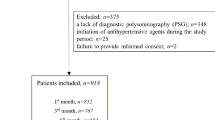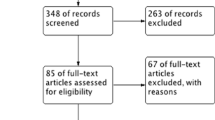Abstract
Background
Continuous positive airway pressure (CPAP) is an effective therapy for obstructive sleep apnea (OSA). However, for patients who already have OSA and coronary heart diseases (CHD) with optimal medications, whether CPAP can reduce the blood pressure (BP) is not clear. This is a controlled study to evaluate the effects of CPAP on BP in Chinese cohorts with CHD under optimal medications.
Methods
Twenty-four patients with CHD and moderate to severe OSA were treated with CPAP and standard care for 1 month. Twenty-four matched control patients were only treated with standard care alone. Baseline demographic data as well as sleep study data was recorded in all patients. Office blood pressure, heart rate, Epworth sleepiness scale (ESS) score, and quality of life (SF-36) of the two groups were compared after 1-month treatment.
Results
Compared with control group, CPAP treatment markedly reduced the morning diastolic BP (Δ −0.8 ± 6.0 vs. Δ −5.1 ± 6.5, respectively, P = 0.023) and improved ESS scores (Δ −0.5 ± 3.2 vs. Δ −5.2 ± 3.1, P < 0.001). In contrast, there were no significant changes in systolic BP (Δ −0.3 ± 7.3 vs. Δ −3.8 ± 11.8, P = 0.225), heart rate, and quality of life.
Conclusions
CPAP treatment for 1 month was associated with significant reduction in diastolic BP and improvement in ESS score. For patients with moderate to severe OSA and CHD under optimal medications, CPAP treatment leads to effective reduction in diastolic blood pressure and improvement in daytime sleepiness.

Similar content being viewed by others
References
Durán J, Esnaola S, Rubio R, Iztueta A (2001) Obstructive sleep apnea–hypopnea and related clinical features in a population-based sample of subjects aged 30 to 70 yr. Am J Respir Crit Care Med 163:685–689
Young T, Evans L, Finn L, Palta M (1997) Estimation of the clinically diagnosed proportion of sleep apnea syndrome in middle-aged men and women. Sleep 20:705–706
Young T, Peppard P, Palta M, Hla KM, Finn L, Morgan B, Skatrud J (1997) Population-based study of sleep-disordered breathing as a risk factor for hypertension. Arch Intern Med 157:1746–1752
Lavie P, Herer P, Hoffstein V (2000) Obstructive sleep apnoea syndrome as a risk factor for hypertension: population study. BMJ 320:479–482
Newman AB, Nieto FJ, Guidry U, Lind BK, Redline S, Pickering TG, Quan SF (2001) Sleep Heart Health Study. Relation of sleep-disordered breathing to cardiovascular risk factors. The Sleep Hearth Health Study. Am J Epidemiol 154:50–59
Shahar E, Whitney CW, Redline S, Lee ET, Newman AB, Javier Nieto F, O’Connor GT, Boland LL, Schwartz JE, Samet JM (2001) Sleep-disordered breathing and cardiovascular disease: cross sectional results of the Sleep Heart Health Study. Am J Respir Crit Care Med 163:19–25
Mooe T, Franklin KA, Holmström K, Rabben T, Wiklund U (2001) Sleep-disordered breathing and coronary artery disease long-term prognosis. Am J Respir Crit Care Med 164(10 Pt 1):1910–1913
Milleron O, Pillière R, Foucher A, de Roquefeuil F, Aegerter P, Jondeau G, Raffestin BG, Dubourg O (2004) Benefits of obstructive sleep apnoea treatment in coronary artery disease: a long-term follow-up study. Eur Heart J 25(9):728–734
Dimsdale JE, Loredo JS, Profant J (2000) Effect of continuous positive airway pressure on blood pressure: a placebo trial. Hypertension 35:144–147
Barbé F, Mayoralas LR, Duran J, Masa JF, Maimó A, Montserrat JM, Monasterio C, Bosch M, Ladaria A, Rubio M, Rubio R, Medinas M, Hernandez L, Vidal S, Douglas NJ, Agustí AG (2001) Treatment with continuous positive airway pressure is not effective in patients with sleep apnea but no daytime sleepiness. A randomised, controlled trial. Ann Intern Med 134:1015–1023
Pepperell JC, Ramdassingh-Dow S, Crosthwaite N, Mullins R, Jenkinson C, Stradling JR, Davies RJ (2002) Ambulatory blood pressure after therapeutic and subtherapeutic nasal continuous positive airway pressure for obstructive sleep apnoea: a randomized parallel trial. Lancet 359:204–210
Aihara K, Chin K, Oga T, Takahashi K, Hitomi T, Takegami M, Handa T, Niimi A, Tsuboi T, Mishima M (2010) Long-term nasal continuous positive airway pressure treatment lowers blood pressure in patients with obstructive sleep apnea regardless of age. Hypertens Res 33:1025–1031
Robinson GV, Smith DM, Langford BA, Davies RJ, Stradling JR (2006) Continuous positive airway pressure does not reduce blood pressure in nonsleepy hypertensive OSA patients. Eur Respir J 27:1229–1235
Norman D, Loredo JS, Nelesen RA, Ancoli-Israel S, Mills PJ, Ziegler MG, Dimsdale JE (2006) Effects of continuous positive airway pressure versus supplemental oxygen on 24-hour ambulatory blood pressure. Hypertension 47:840–845
Haentjens P, Van Meerhaeghe A, Moscariello A, De Weerdt S, Poppe K, Dupont A, Velkeniers B (2007) The impact of continuous positive airway pressure on blood pressure in patients with obstructive sleep apnea syndrome: evidence from a meta-analysis of placebo-controlled randomized trials. Arch Intern Med 167:757–764
Turnbull F, Blood Pressure Lowering Treatment Trialists’ Collaboration (2003) Effects of different blood-pressure-lowering regimens on major cardiovascular events: results of prospectively-designed overviews of randomised trials. Lancet 362(9395):1527–1535
Fung JW, Li TS, Choy DK, Yip GW, Ko FW, Sanderson JE, Hui DS (2002) Severe obstructive sleep apnea is associated with left ventricular diastolic dysfunction. Chest 121:422–429
Hui DS, Choy DK, Wong LK, Ko FW, Li TS, Woo J, Kay R (2002) Prevalence of sleep-disordered breathing and continuous positive airway pressure compliance: results in Chinese patients with first-ever ischemic stroke. Chest 122:852–860
Johns MW (1991) A new method for measuring daytime sleepiness: the Epworth Sleepiness Scale. Sleep 14:540–545
Chung KF (2000) Use of the Epworth Sleepiness Scale in Chinese patients with obstructive sleep apnea and normal hospital employees. J Psychosom Res 49:367–372
Tarlov AR, Ware JE, Greenfield S, Nelson EC, Perrin E, Zubkoff M (1989) The Medical Outcomes Study: an application of methods for monitoring the results of medical care. JAMA 262:925–930
Alonso J, Regidor E, Barrio G, Prielto L, Rodríguez C, de la Fuente L (1998) Valores poblacionales de referencia de la versión española del Cuestionario de Salud SF-36 [Population reference values of the Spanish version of the Health Questionnaire SF-36]. Med Clin (Barc) 111:410–416
Bazzano L, Khan Z, Reynolds K, He J (2007) Effect of nocturnal nasal continuous positive airway pressure on blood pressure in obstructive sleep apnea. Hypertension 50:1–7
Becker HF, Jerrentrup A, Ploch T, Grote L, Penzel T, Sullivan CE, Peter JH (2003) Effect of nasal continuous positive airway pressure treatment on blood pressure in patients with obstructive sleep apnea. Circulation 107:68–73
Middleton S, Vermeulen W, Byth K, Sullivan CE, Middleton PG (2009) Treatment of obstructive sleep apnoea in Samoa progressively reduces daytime blood pressure over 6 months. Respirology 14(3):404–410
Sharabi Y, Scope A, Chorney N, Grotto I, Dagan Y (2003) Diastolic blood pressure is the first to rise in association with early subclinical obstructive sleep apnea: lessons from periodic examination screening. Am J Hypertens 16(3):236–239
Davies CW, Crosby JH, Mullins RL, Barbour C, Davies RJ, Stradling JR (2000) Case–control study of 24 hour ambulatory blood pressure in patients with obstructive sleep apnoea and normal matched control subjects. Thorax 55(9):736–740
Narkiewicz K, Kato M, Phillips BG, Pesek CA, Davison DE, Somers VK (1999) Nocturnal continuous positive airway pressure decreases daytime sympathetic traffic in obstructive sleep apnea. Circulation 100(23):2332–2335
Maser RE, Lenhard MJ, Rizzo AA, Vasile AA (2008) Continuous positive airway pressure therapy improves cardiovascular autonomic function for persons with sleep-disordered breathing. Chest 133(1):86–91
MacMahon S, Peto R, Cutler J, Collins R, Sorlie P, Neaton J, Abbott R, Godwin J, Dyer A, Stamler J (1990) Blood pressure, stroke, and coronary heart disease. Part 1, prolonged differences in blood pressure: prospective observational studies corrected for the regression dilution bias. Lancet 335:765–774
Alajmi M, Mulgrew AT, Fox J, Davidson W, Schulzer M, Mak E, Ryan CF, Fleetham J, Choi P, Ayas NT (2007) Impact of continuous positive airway pressure therapy on blood pressure in patients with obstructive sleep apnea hypopnea: a meta-analysis of randomized controlled trials. Lung 185:62–72
Mo L, He QY (2007) Effect of long-term continuous positive airway pressure ventilation on blood pressure in patients with obstructive sleep apnea hypopnea syndrome: a meta-analysis of clinical trials. Zhonghua Yi Xue Za Zhi 87:1177–1180
Martínez-García MA, Soler-Cataluña JJ, Román-Sánchez P, González V, Amorós C, Montserrat JM (2009) Obstructive sleep apnea has little impact on quality of life in the elderly. Sleep Med 10(1):104–111
Engleman HM, Kingshott RN, Wraith PK, Mackay TW, Deary IJ, Douglas NJ (1999) Randomized placebo-controlled crossover trial of continuous positive airway pressure for mild sleep apnea/hypopnea syndrome. Am J Respir Crit Care Med 159(2):461–467
Siccoli MM, Pepperell JC, Kohler M, Craig SE, Davies RJ, Stradling JR (2008) Effects of continuous positive airway pressure on quality of life in patients with moderate to severe obstructive sleep apnea: data from a randomized controlled trial. Sleep 31(11):1551–1558
Mansfield DR, Gollogly NC, Kaye DM, Richardson M, Bergin P, Naughton MT (2004) Controlled trial of continuous positive airway pressure in obstructive sleep apnea and heart failure. Am J Respir Crit Care Med 169(3):361–366
Hróbjartsson A, Gøtzsche PC (2001) Is the placebo powerless? An analysis of clinical trials comparing placebo with no treatment. N Engl J Med 344(21):1594–1602
Acknowledgments
We thankfully acknowledge the doctors of our Department of Medicine, the staff members of sleep center for numerous sleepless nights they spent in performing polysomnography, and the support staff who helped us to collect reliable and meaningful information about our study subjects.
Author information
Authors and Affiliations
Corresponding author
Rights and permissions
About this article
Cite this article
Zhao, Q., Liu, Zh., Luo, Q. et al. Effects of continuous positive airway pressure on blood pressure and daytime sleepiness in obstructive sleep apnea patients with coronary heart diseases under optimal medications. Sleep Breath 16, 341–347 (2012). https://doi.org/10.1007/s11325-011-0498-9
Received:
Revised:
Accepted:
Published:
Issue Date:
DOI: https://doi.org/10.1007/s11325-011-0498-9




